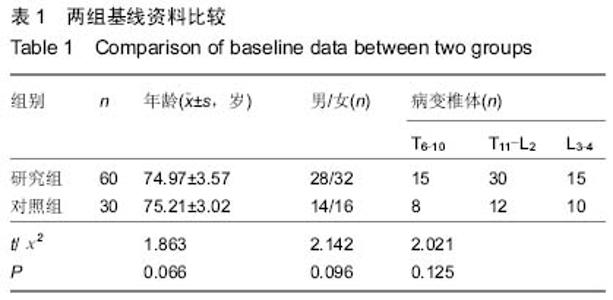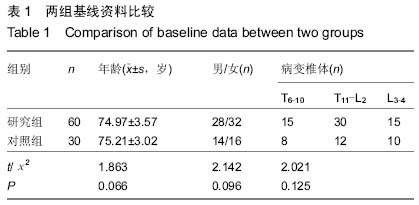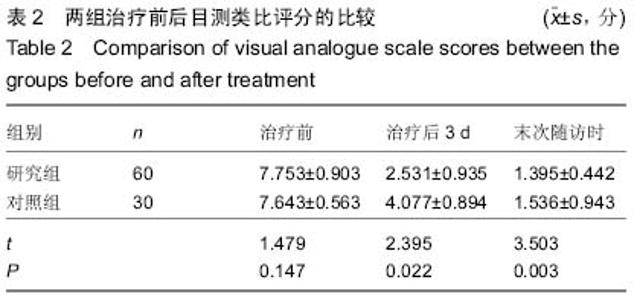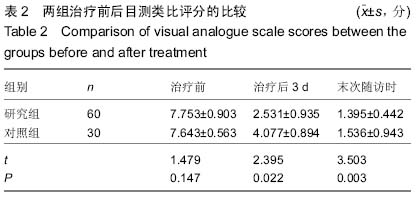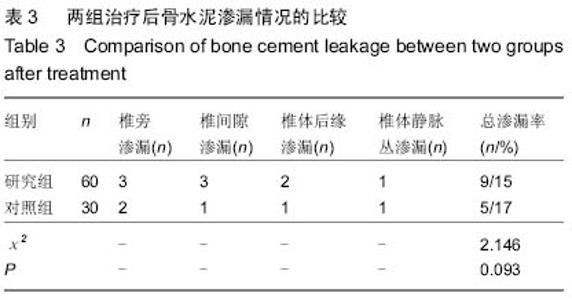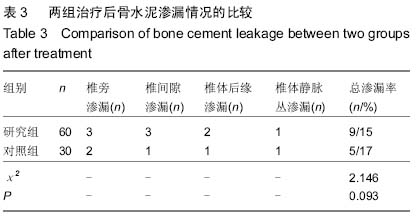Chinese Journal of Tissue Engineering Research ›› 2015, Vol. 19 ›› Issue (21): 3287-3291.doi: 10.3969/j.issn.2095-4344.2015.21.002
Previous Articles Next Articles
Bone cement dispersion within the fracture line influences the therapeutic efficacy of percutaneous vertebroplasty on thoracolumbar osteoporotic vertebral compression fractures
Chen Tong-lin1, Yong Yi-min2, Peng Yin-ping1, Xie Hong-feng1, Jia Wei-dou1
- 1Department of Orthopaedics, Beijing Chaoyang Emergency Medical Center, Beijing 100122, China; 2Department of Orthopaedics, Xuanwu Hospital, Capital Medical University, Beijing 100053, China
-
Online:2015-05-21Published:2015-05-21 -
About author:Chen Tong-lin, Attending physician, Department of Orthopaedics, Beijing Chaoyang Emergency Medical Center, Beijing 100122, China
CLC Number:
Cite this article
Chen Tong-lin, Yong Yi-min, Peng Yin-ping, Xie Hong-feng, Jia Wei-dou. Bone cement dispersion within the fracture line influences the therapeutic efficacy of percutaneous vertebroplasty on thoracolumbar osteoporotic vertebral compression fractures [J]. Chinese Journal of Tissue Engineering Research, 2015, 19(21): 3287-3291.
share this article
| [1] 刘瑶瑶,孙东,罗飞,等.新型可注射骨水泥椎弓根螺钉的设计及生物力学研究[J].中国创伤杂志,2012,28(8):744-747. [2] 王尔天,易伟宏,黄曹,等.PVP与 PKP治疗骨质疏松性压缩骨折时骨水泥填充效果及弥散方式的比较研究[J].中国伤残医学, 2010,18(5):2-4. [3] 江晓兵,莫凌,梁德,等.骨水泥在椎体骨折线内弥散情况对椎体成形术治疗效果的影响[J]. 中国脊柱脊髓杂志,2014,24(4): 144-149. [4] Ma R,Chow R,Shen FH.Kummell’s disease: delayed post-traumatic osteonecrosis of the vertebral body.Eur Spine J.2010;19(7):1065-1070. [5] 庄澄宇,陈哲,宋艳艳,等.经皮椎体成形术和经皮椎体后凸成形术治疗不同压缩程度骨质疏松性椎体骨折疗效的比较[J].中华创伤骨科杂志,2013,15(9):773-777. [6] Papanastassiou ID,Phillips FM,Van Meirhaeghe J,et al. Comparing effects of kyphnplasty, vertebroplasty, anti nonsurgical management in a systenmtic review of randomized and non-randomized controlled studies. Eur Spine J.2012;21(4):1826-1843. [7] 洪鑫,吴小涛,刘磊,等.经皮椎体成形术和经皮椎体后凸成形术治疗重度骨质疏松性椎体压缩性骨折疗效分析[J].中国骨质疏松杂志,2011,11(17):969-973. [8] 唐海,陈浩,王炳,等.椎体后凸成形术治疗重度骨质疏松性椎体压缩性骨折[J]. 2010,30(10):978-9893. [9] 吴强,莫世赞,包拥政,等.椎体成形治疗后骨水泥在椎体内弥散的影响因素[J].中国组织工程研究,2014,18(43):6922-6928. [10] 张亮,高梁斌,李健,等.椎体成形术中椎体骨密度对骨水泥弥散体积的影响[J].中国脊柱脊髓杂志,2011,21(11):915-918. [11] 薄冉,杨庆国,段文,等.软骨终板形态与椎间盘退变的相关性[J].中国组织工程研究, 2012,16(24):4413-4416. [12] 王骅,静成,王永祥.自体骨椎体成形术的生物力学研究[J].实用医药杂志,2013,17(1):1-4. [13] 王强,申剑,纪泉,等.老年椎体压缩性骨折患者强化椎体强化治疗的疗效和并发症探讨[J]. 中华老年医学杂志,2014,33(7): 768-771. [14] 杨岱青.骨水泥强化椎弓钉内固定伤椎椎体成形术治疗骨质疏松症椎体骨折效果观察[J]. 现代中西医结合杂志,2013,22(4): 393-394. [15] 魏玉峰,刘志杰.经皮椎体成形术治疗骨质疏松性椎体骨折的疗效及并发症[J].中国老年学杂志,2013,33(16):4056-4057. [16] 冯新民,王静成,张亮,等.高粘度骨水泥在修复骨质疏松性胸腰椎骨折中的应用[J].中国组织工程研究,2014,18(30):4757-4763. [17] 柴仪,刘法敬,申勇.经皮椎体后凸成形术治疗高领骨质疏松性椎体压缩骨折[J].中国老年学杂志,2013,33(9):4574-4575. [18] 胡丽叶,朱旅云,李晓玲,等.原发性骨质疏松569例发病的相关因素[J].中国老年学杂志, 2010,29(10):829-831. [19] 朱洲,王生介,厉晓龙,等.聚甲基丙烯酸甲酯骨水泥椎体成形与保守治疗胸腰椎体新鲜骨质疏松性压缩骨折的比较[J].中国组织工程研究,2014,18(39):6271-6275. [20] 陈柏龄,谢登辉,黎艺强,等.单侧PKP骨水泥注射过中线分布对压缩性骨折椎体两侧刚度的影响[J].中国脊柱脊髓杂志,2011, 21(2): 118-121. [21] 申勇,刘法敬,张英泽,等.单、双侧经皮椎体晤凸成形术治疗骨质疏松性椎体压缩骨折的疗效[J].中国脊柱脊髓杂志,2011,21(3): 202-206. [22] 徐建成,白靖平,锡林宝勒日,等.注入骨水泥椎体成形与非手术治疗骨质疏松性椎体压缩骨折的Meta分析[J].中国组织工程研究与临床康复,2011,15(13):2366-2370. [23] 唐骅,刘培来,李明.经皮椎体成形术治疗椎体压缩性骨折56例疗效观察[J].山东医药,2011,51(3):61-62. [24] Chen B, Li Y,Xie D,et al.Comparison of unipedicular and bipedicular kyphoplasty on the stiffness and biomechanical balance of compression fractured vertebrae.Eur Spine J. 2011; 20(8):1272-1280. [25] Yang XM,Wu TL,Xu HG,et al.Modified unilateral transpedicular percutaneous vertebroplasty for treatment of osteoporotic vertebral compression fractures.Orthop Surg. 2011;3(4):247-252. [26] 刘家旭,贺云.单侧经皮球囊扩张椎体后凸成形术治疗胸腰 椎体压缩性骨折36例疗效观察[J].中国伤残医学, 2013, 21(12): 70-71. [27] 陈卫,倪才方,王煊,等.经皮椎体成形术及后凸成形术治疗骨质疏松性椎体压缩骨折的临床对比研究[J]中华放射学杂志,2011, 45(9):859-861. [28] 孟飞,曾文魁,王愉思,等.PKP与PVP治疗骨质疏松性腰椎压缩骨折的比较分析[J]军医进修学院学报,2012,33(1):56-58. [29] 王胜华, 陈成东, 周国顺, 等. 椎体凸成形联合骨水泥强化椎弓根内固定治疗重度骨质疏松性胸腰椎压缩性骨折[J].浙江医学, 2014, 36(11):977-978. [30] 赵志刚,勘武生,李鹏.经皮椎体成形术治疗新鲜骨质疏松性椎体压缩性骨折[J].中华创伤骨科杂志,2014,16(3):218-221. |
| [1] | Chen Ziyang, Pu Rui, Deng Shuang, Yuan Lingyan. Regulatory effect of exosomes on exercise-mediated insulin resistance diseases [J]. Chinese Journal of Tissue Engineering Research, 2021, 25(25): 4089-4094. |
| [2] | Chen Yang, Huang Denggao, Gao Yuanhui, Wang Shunlan, Cao Hui, Zheng Linlin, He Haowei, Luo Siqin, Xiao Jingchuan, Zhang Yingai, Zhang Shufang. Low-intensity pulsed ultrasound promotes the proliferation and adhesion of human adipose-derived mesenchymal stem cells [J]. Chinese Journal of Tissue Engineering Research, 2021, 25(25): 3949-3955. |
| [3] | Yang Junhui, Luo Jinli, Yuan Xiaoping. Effects of human growth hormone on proliferation and osteogenic differentiation of human periodontal ligament stem cells [J]. Chinese Journal of Tissue Engineering Research, 2021, 25(25): 3956-3961. |
| [4] | Sun Jianwei, Yang Xinming, Zhang Ying. Effect of montelukast combined with bone marrow mesenchymal stem cell transplantation on spinal cord injury in rat models [J]. Chinese Journal of Tissue Engineering Research, 2021, 25(25): 3962-3969. |
| [5] | Gao Shan, Huang Dongjing, Hong Haiman, Jia Jingqiao, Meng Fei. Comparison on the curative effect of human placenta-derived mesenchymal stem cells and induced islet-like cells in gestational diabetes mellitus rats [J]. Chinese Journal of Tissue Engineering Research, 2021, 25(25): 3981-3987. |
| [6] | Hao Xiaona, Zhang Yingjie, Li Yuyun, Xu Tao. Bone marrow mesenchymal stem cells overexpressing prolyl oligopeptidase on the repair of liver fibrosis in rat models [J]. Chinese Journal of Tissue Engineering Research, 2021, 25(25): 3988-3993. |
| [7] | Liu Jianyou, Jia Zhongwei, Niu Jiawei, Cao Xinjie, Zhang Dong, Wei Jie. A new method for measuring the anteversion angle of the femoral neck by constructing the three-dimensional digital model of the femur [J]. Chinese Journal of Tissue Engineering Research, 2021, 25(24): 3779-3783. |
| [8] | Meng Lingjie, Qian Hui, Sheng Xiaolei, Lu Jianfeng, Huang Jianping, Qi Liangang, Liu Zongbao. Application of three-dimensional printing technology combined with bone cement in minimally invasive treatment of the collapsed Sanders III type of calcaneal fractures [J]. Chinese Journal of Tissue Engineering Research, 2021, 25(24): 3784-3789. |
| [9] | Qian Xuankun, Huang Hefei, Wu Chengcong, Liu Keting, Ou Hua, Zhang Jinpeng, Ren Jing, Wan Jianshan. Computer-assisted navigation combined with minimally invasive transforaminal lumbar interbody fusion for lumbar spondylolisthesis [J]. Chinese Journal of Tissue Engineering Research, 2021, 25(24): 3790-3795. |
| [10] | Hu Jing, Xiang Yang, Ye Chuan, Han Ziji. Three-dimensional printing assisted screw placement and freehand pedicle screw fixation in the treatment of thoracolumbar fractures: 1-year follow-up [J]. Chinese Journal of Tissue Engineering Research, 2021, 25(24): 3804-3809. |
| [11] | Shu Qihang, Liao Yijia, Xue Jingbo, Yan Yiguo, Wang Cheng. Three-dimensional finite element analysis of a new three-dimensional printed porous fusion cage for cervical vertebra [J]. Chinese Journal of Tissue Engineering Research, 2021, 25(24): 3810-3815. |
| [12] | Wang Yihan, Li Yang, Zhang Ling, Zhang Rui, Xu Ruida, Han Xiaofeng, Cheng Guangqi, Wang Weil. Application of three-dimensional visualization technology for digital orthopedics in the reduction and fixation of intertrochanteric fracture [J]. Chinese Journal of Tissue Engineering Research, 2021, 25(24): 3816-3820. |
| [13] | Sun Maji, Wang Qiuan, Zhang Xingchen, Guo Chong, Yuan Feng, Guo Kaijin. Development and biomechanical analysis of a new anterior cervical pedicle screw fixation system [J]. Chinese Journal of Tissue Engineering Research, 2021, 25(24): 3821-3825. |
| [14] | Lin Wang, Wang Yingying, Guo Weizhong, Yuan Cuihua, Xu Shenggui, Zhang Shenshen, Lin Chengshou. Adopting expanded lateral approach to enhance the mechanical stability and knee function for treating posterolateral column fracture of tibial plateau [J]. Chinese Journal of Tissue Engineering Research, 2021, 25(24): 3826-3827. |
| [15] | Zhu Yun, Chen Yu, Qiu Hao, Liu Dun, Jin Guorong, Chen Shimou, Weng Zheng. Finite element analysis for treatment of osteoporotic femoral fracture with far cortical locking screw [J]. Chinese Journal of Tissue Engineering Research, 2021, 25(24): 3832-3837. |
| Viewed | ||||||
|
Full text |
|
|||||
|
Abstract |
|
|||||
